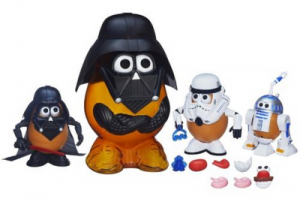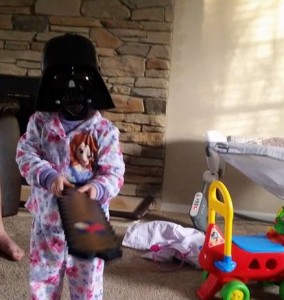Toys, like Star Wars Mr. Potato Head and Darth Vader can help kids learn facial expressions. Facial expressions are a significant part of our communication with each other but not only do kids have to ‘read’ the expression, they also have to match it to the feeling.
 Newborns respond to smiles with delight and toddlers are pretty good at realizing a particular look on a parent or caregiver’s face means oh-oh. But there are so many more than expressions and emotions than happy, sad, and angry. Worried, frustrated, scared, nervous, surprised—the list is extensive. No wonder it’s such a challenge.
Newborns respond to smiles with delight and toddlers are pretty good at realizing a particular look on a parent or caregiver’s face means oh-oh. But there are so many more than expressions and emotions than happy, sad, and angry. Worried, frustrated, scared, nervous, surprised—the list is extensive. No wonder it’s such a challenge.
It’s easy to see how a toy like Mr. Potato Head is useful. Kids get to make faces and try out some mouths and eyes. The lips can be turned up or down but Mr. or Mrs. Potato Head doesn’t have much range beyond basic feelings. The mixing and matching can be fun even if it’s limited. Play certainly helps kids learn facial expressions.
How can Darth Vader help kids? His face has no expression at all. That’s a significant part of the reason why he is powerful and menacing. There are no clues as to what he is thinking and feeling. He doesn’t give anything away because he can hide behind his mask. Just wearing a Darth Vader face can give kids some of this power too. Without revealing themselves, they can really look at our faces. Kids are not quite so vulnerable with a Darth Vader blank face. No wonder some of them want to wear it all day long.
 While no parent wants to be as scary as Darth Vader, we do hope the expression on our face communicates a message. Another way to have fun with facial expressions is to make silly ones. Often, there is someone in the family circle who is especially good at this. I had an uncle who made the best monkey faces and could even wiggle his ears.
While no parent wants to be as scary as Darth Vader, we do hope the expression on our face communicates a message. Another way to have fun with facial expressions is to make silly ones. Often, there is someone in the family circle who is especially good at this. I had an uncle who made the best monkey faces and could even wiggle his ears.
For some fun today, can you and your child make some Darth Vader and other expressions without the mask? 🙂 🙁 😉 ;( 😀
